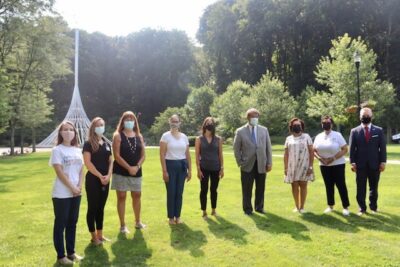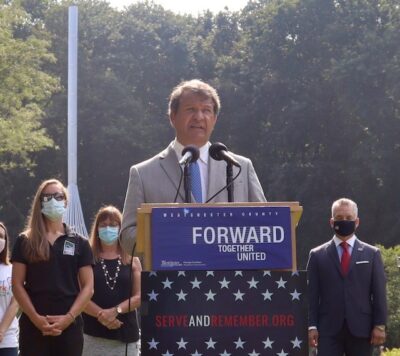Donations Encouraged at County Office Building
Westchester County Executive George Latimer is commending County employees for coming together to donate what they can to help Bronx families impacted by Sunday’s devastating and deadly fire that claimed the lives of 17 people, including 8 children.
Latimer said: “We are grieving with our brothers and sisters in the Bronx. For years Westchester has had a strong connection to the Bronx and that link is undeniable. It is our duty to give back and help our neighbors who have lost so much. We want to help them heal, rebuild and let them know we are here for them. Our hearts are with the survivors and the families left behind as we share in this loss.”
Assistant County Attorney Irma Cosgriff approached the County Executive about setting up a donation drive to help the families after hearing of the tragedy.
Cosgriff said: “I had an overwhelming sense of sadness for the individuals and families affected by this tragedy and wanted to do something to help. We want to provide an easy and trusted way for County employees’ donations to be most effective. This is about us doing something.”
A donation box at Michaelian Office Building at 148 Martine Avenue in White Plains has been set up to receive donations beginning Friday, January 14 through January 21. Employees are asked to place their donations in large transportable plastic bags. The items will be donated to PS-85 Great Expectations School, where many of the children impacted by this fire, attended.
Essential items needed include: bottled water, pillows, blankets, non-perishable food, sanitizer, toiletries, feminine hygiene products, pet products, new and unworn clothing (sweatpants, sweatshirts, undershirts, socks, kids and adult-sized underwear, kids and adult-sized pajamas), diapers and baby items and unused bedding.
County residents are encouraged to assist where they can. Monetary donations can be made via the links provided below:
MONETARY DONATION LINKS:
- Gambian Youth Organization
- NYC Mayor’s Office Victim Fund
- BStrong
- Bronx Fire Relief organized by community advocate Deepti Sharma
- Bronx Community Foundation Fund
- Please designate your donation as “Fire Community Relief Effort.”
- Riverdale Jewish Center
- Please note that the funds are meant for the victims of the Bronx fire in the “Payment Notes” section News courtesy of the County Executive




 In honor of former AFP National Philanthropy Day Conference Event Chair and board member Janet Pollack who passed away in April 2021, a membership scholarship has been created in her memory with the winner to be announced at this year’s National Philanthropy Day Conference. Janet was a champion for nonprofit organizations and the AFP, NY Westchester Board of Directors has put together this scholarship in celebration of her life and service. The one year membership is available for individuals who have never been members of AFP Westchester, conduct fundraising in Westchester County, and serve organizations with less than a $1,000,000 budget. For those who are interested in applying, please visit
In honor of former AFP National Philanthropy Day Conference Event Chair and board member Janet Pollack who passed away in April 2021, a membership scholarship has been created in her memory with the winner to be announced at this year’s National Philanthropy Day Conference. Janet was a champion for nonprofit organizations and the AFP, NY Westchester Board of Directors has put together this scholarship in celebration of her life and service. The one year membership is available for individuals who have never been members of AFP Westchester, conduct fundraising in Westchester County, and serve organizations with less than a $1,000,000 budget. For those who are interested in applying, please visit  Andrew Greenspan is a native New Yorker who has resided in Westchester for nearly his entire life. He is a graduate of Scarsdale High School, has a Bachelor of Arts from Hamilton College, and a Master of Science from the Sloan School of Business at MIT. In 1999, he founded GHP Office Realty with James J. Houlihan. As Principal of GHP, he manages the daily operations of the White Plains based company, which began by acquiring and operating individual multi-tenanted suburban New York office buildings. The partners presently own and manage buildings in Westchester, Rockland, Fairfield, and Bergen Counties.
Andrew Greenspan is a native New Yorker who has resided in Westchester for nearly his entire life. He is a graduate of Scarsdale High School, has a Bachelor of Arts from Hamilton College, and a Master of Science from the Sloan School of Business at MIT. In 1999, he founded GHP Office Realty with James J. Houlihan. As Principal of GHP, he manages the daily operations of the White Plains based company, which began by acquiring and operating individual multi-tenanted suburban New York office buildings. The partners presently own and manage buildings in Westchester, Rockland, Fairfield, and Bergen Counties.






 “This year’s 20th anniversary serves a grim reminder of the nation’s darkest day, but it also reminds us of how thousands came together afterward, helping each other, comforting each other and rising through tragedy. We encourage everyone to participate to honor the lives lost and pay tribute to the first responders who saved lives and continue to battle illnesses acquired from that day,” said County Executive George Latimer.
“This year’s 20th anniversary serves a grim reminder of the nation’s darkest day, but it also reminds us of how thousands came together afterward, helping each other, comforting each other and rising through tragedy. We encourage everyone to participate to honor the lives lost and pay tribute to the first responders who saved lives and continue to battle illnesses acquired from that day,” said County Executive George Latimer.

